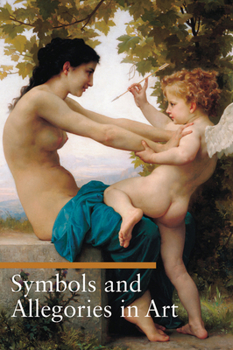Symbols and Allegories in Art
(Book #17 in the A Guide to Imagery Series)
Select Format
Select Condition 
Book Overview
From antiquity, when the gods and goddesses were commonly featured in works of art, through to the twentieth century, when Surrealists drew on archetypes from the unconscious, artists have embedded symbols in their works. As with previous volumes in the Guide to Imagery series, the goal of this book is to provide contemporary readers and museum visitors with the tools to read the hidden meanings in works of art.
This latest volume is divided thematically into four sections featuring symbols related to time, man, space (earth and sky), and allegories or moral lessons. Readers will learn, for instance, that night, the primordial mother of the cosmos, was often portrayed in ancient art as a woman wrapped in a black veil, whereas day or noon was often represented in Renaissance art as a strong, virile man evoking the full manifestation of the sun's energy.
Each entry in the book contains a main reference image in which details of the symbol or allegory being analyzed are called out for discussion. In the margin, for quick access by the reader, is a summary of the essential characteristics of the symbol in question, the derivation of its name, and the religious tradition from which it springs.
This latest volume is divided thematically into four sections featuring symbols related to time, man, space (earth and sky), and allegories or moral lessons. Readers will learn, for instance, that night, the primordial mother of the cosmos, was often portrayed in ancient art as a woman wrapped in a black veil, whereas day or noon was often represented in Renaissance art as a strong, virile man evoking the full manifestation of the sun's energy.
Each entry in the book contains a main reference image in which details of the symbol or allegory being analyzed are called out for discussion. In the margin, for quick access by the reader, is a summary of the essential characteristics of the symbol in question, the derivation of its name, and the religious tradition from which it springs.
Format:Paperback
Language:English
ISBN:0892368187
ISBN13:9780892368181
Release Date:May 2005
Publisher:J. Paul Getty Museum
Length:384 Pages
Weight:1.57 lbs.
Dimensions:1.2" x 5.3" x 7.8"
Customer Reviews
2 ratings
Very useful
Published by Thriftbooks.com User , 15 years ago
I love to study classical paintings and to discover their hidden symbols. This book was very useful for me, because there is no definitive books for this subject. Otherwise, English isn't my native language, but I could read the book without difficulty.
A Valuable Guide to Understanding References in Paintings
Published by Thriftbooks.com User , 19 years ago
SYMBOLS AND ALLEGORIES IN ART was originally published in Italian by author Mathilde Battistini and is here resubmitted to the art loving public in a translated version courtesy of the Getty Foundation. The book is visually stunning and informative and offers a very handy reference volume for the museum visitor as well as the artist in understanding the derivation of symbols and myths and allegories that have sustained a presence in painting since the Baroque period. Well designed in a logical way, each symbol or mythological character or even still life component is fully illustrated with a full page painting and accompanied by a terse but informative few paragraphs of explanation. The fine aspect is the manner in which each painting is easily identified at the moment it is introduced, and even though a fine bibliography is found in the back of the book, for once the information necessary to make the 'connect' is right before the eyes of the viewer. This well illustrated volume is a welcome adjunct to the art history library as well as an interesting companion for the reader whose fascination in mythology is what brings them to art in the first place! Recommended. Grady Harp, February 06





